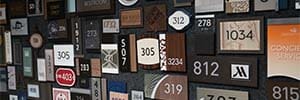The Importance of Retail Design

The truth about retail design is that it is much more than looks. Visual merchandising and store design expert Eric Feigenbaum recently wrote, “Any successful retail strategy must be built upon a dynamic connection between science and art.”
The key is not only to predict customers’ behaviors from a methodical study of their wants and needs, but also to create a sales concept that will appeal to their emotions – and increase their spend. Consumers do not simply want to go to a store to buy things; they want an experience.
And this approach has a name: experiential retail. One retail and commercial space designer put it this way: “It starts with the entrance and takes the shape of the air circulating through your store. Everything you see (and often don’t see) is catered to the customer. It is aimed at the customer to influence their buying intent.”
Identity Group is an industry leader in custom-designed retail environments, including retail store signs, pop-up signage, and displays. Contact us.
The End-Goal of Retail Design, and How to Achieve It
When customers have a positive shopping experience while in your store, 90% of them will likely return. That number speaks to the primary end-goal of retail design: sales and loyalty.
Retail design should first increase your foot traffic and sales. But, simultaneously, it should be positioning your brand as a retailer they want to return to again and again.
With this in mind, here are a few important retail design elements and considerations that can increase your chances for success:
- Cross Merchandise
- Creative Retail Signage
- Accessibility
- Sensory Appeal
Cross Merchandise
Cross merchandising is perhaps the most common example of an experiential retail design tactic. From clothing outlets to grocery stores, all use cross merchandising to group together items that make sense logically, especially if they look good together (e.g. plaid pants and matching accessories, such as a black purse).
Creative Retail Signage
Creative retail store signage, pop-up signs, and custom retail displays are the name of the game in retail. When creating your environmental retail design strategy, consider the unique and fun ways neon signs, banners, 3D letters or images, and social media photo opportunities can enhance your product and delight your customer. In fact, pop-ups are considered an important design element that makes your brand memorable.
Accessibility
Something that speaks to customers is being considerate, and that is true for customers of every ability. Ensure that your retail space is accessible with merchandise placed within reach, aisles and pathways wide enough for wheelchairs, and signs that are ADA compliant.
Sensory Appeal
Even though retail design largely takes visual components into account, there is something to be said about the other senses, including scent, touch, and sound. A more immersive retail experience considers the music playlist and the mood it creates; whether the smell of the atmosphere is enticing and bringing customers in the store; and if shoppers can interact with products through hands-on opportunities.
Identity Group’s diverse team of designers are constantly innovating and making products that stand out. Contact us about bringing your vision to life, and visit our website for inspiration!
